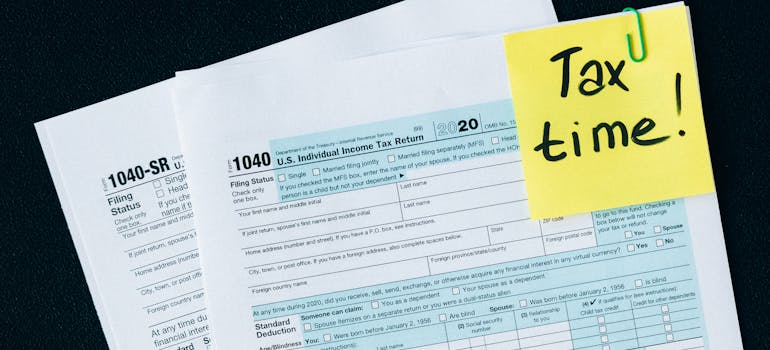All You Need to Know About Moving Expenses Tax Deduction
Besides logistical challenges, relocating for work also presents unique financial opportunities, particularly through the moving expenses tax deduction. This aspect of tax law permits those who move due to work requirements to potentially reduce their taxable income by claiming certain moving-related expenses. Exploring the nuances of what qualifies for this deduction can significantly impact your financial situation post-move with the best movers Seattle has, making it a crucial consideration for anyone undergoing a work-related relocation.
What Constitutes Tax Deduction on Moving Expenses
If you’re unfamiliar with tax benefits and find yourself facing a work-related move, the tax deduction on moving expenses is a crucial concept to grasp. This write-off allows you to lower your taxable income by claiming specific costs involved in relocating for a job, such as hiring moving services, renting trucks, and travel expenses to your new residence.
This tax provision is designed to alleviate the financial burden of moving for work, recognizing the significant costs involved. Understanding how to leverage this deduction can lead to tangible savings at tax time. It’s about making your move work for you financially, connecting the dots between your relocation expenses and their impact on your taxes.
Eligibility Criteria for Moving Expenses Tax Deduction
Understanding the eligibility criteria is paramount to capitalize on the relocation expenses tax deduction. This deduction is not universally applicable; it targets specific situations, primarily work-related relocations. Here’s a breakdown of the key criteria you need to meet to claim this deduction after moving with a moving company Washington State recommends.

General Eligibility
The IRS sets forth two primary tests to determine eligibility for the moving expenses tax reduction: the Distance Test and the Time Test.
- The Distance Test requires your new job location to be at least 50 miles farther from your old home than your old job location. If you previously worked 10 miles from your old home, your new job must be at least 60 miles from that home.
- The Time Test mandates that you must be employed full-time for at least 39 weeks within the first 12 months immediately following your move. For the self-employed, the requirement extends to 78 weeks within the first 24 months, with at least 39 of those weeks within the first 12 months.
Special Considerations for Retirees
There are specific criteria and scenarios where are moving expenses tax deductible for retirees. The moving expense tax deductions may still apply, especially if you’re moving back to the United States from a foreign country after retiring or if you’re moving within the United States to a new home closer to your job location before retiring. The same distance and time tests apply, ensuring that if your move is closely related to the end of your work life, it’s considered for deduction.
Provisions for the Self-Employed
Similarly, there are unique conditions under which are moving expenses tax deductible for self-employed individuals. These professionals can also qualify for the moving expenses deduction but with a slightly extended version of the Time Test.
If you’re self-employed, you’ll need to work full-time for at least 78 weeks during the first 24 months after you move, with at least 39 of those weeks within the first 12 months. This ensures that the self-employed using office movers in Seattle are genuinely relocating for work purposes and establishes a commitment to maintaining and growing their business in a new location.
Understanding the Eligibility
The intricacies of these criteria highlight the IRS’s aim to support work-related moves while preventing abuse of the deduction. It’s crucial to document your moving expenses meticulously and ensure your move meets these eligibility requirements. Keep in mind that changes in tax law, such as those introduced by the Tax Cuts and Jobs Act of 2017, have temporarily suspended the moving expenses deduction for most taxpayers until 2025, with exceptions for members of the Armed Forces.
This detailed eligibility framework ensures that if you’re moving for work, whether you’re traditionally employed, self-employed, or retiring, you understand the potential for a moving expenses tax deduction. However, given the nuances of tax law and its potential changes, consulting with a tax professional is advisable to navigate your specific situation effectively.

Qualifying Expenses
When it comes to the moving expenses tax deduction, not all expenses incurred during your move are eligible for deduction. It’s essential to distinguish between deductible and non-deductible moving expenses to ensure you’re maximizing your tax benefits without misstepping IRS guidelines. Here’s an overview of what qualifies and what doesn’t.
Deductible Moving Expenses
Deductible moving expenses are primarily those necessary for moving your household goods and personal effects, along with travel costs to your new home. These include:
- Moving household goods and personal effects;
- Travel expenses.
Costs associated with packing, crating, and transporting your moving boxes Seattle can offer from your old home to your new one are deductible. This category can also cover the costs of storing and insuring these items for up to 30 days after moving out of your old home.
Expenses for traveling to your new home, including lodging during the trip, which does not include meals’ cost, can also be written off. The IRS allows you to deduct these expenses for one trip per person. You can choose to deduct the actual expenses or use the standard mileage rate for moving, as specified by the IRS for the year of your move, plus parking fees and tolls.
Non-Deductible Moving Expenses
Several expenses related to moving do not qualify for the tax deduction, including:
- Temporary Living Expenses: Costs for temporary housing in your new city are not deductible.
- Meal Costs During the Move: While lodging on the way to your new home can be deducted, the cost of meals during the move cannot.
- Real Estate Costs: Expenses involved in buying or selling a home, such as closing costs, mortgage fees, and real estate commissions, are not deductible as moving expenses.
- Costs for Breaking or Entering a Lease: Any penalties paid for breaking a lease at your old home or fees associated with securing a lease at your new residence cannot be deducted.
Remember, the eligibility for deducting moving expenses has been suspended for most taxpayers from 2018 through 2025, except for members of the Armed Forces. Always consult the latest IRS guidelines or a tax professional to understand how current laws apply to your situation.
Maximizing Your Deduction
Understanding the distinction between deductible and non-deductible moving expenses is crucial for accurately reporting your moving expenses and maximizing your tax deduction. Keep all receipts and records of your moving expenses, as the IRS may require documentation to substantiate your deduction.

Planning and budgeting your move with these guidelines in mind can help you make informed decisions about which moving services in Seattle and expenses to incur, ensuring you’re not only making a smooth transition to your new home but also taking full advantage of available tax benefits.
How to Claim Moving Expenses Tax Deduction
While the deduction limits to members of the Armed Forces moving due to a military order for the time being, knowing how to claim this benefit is essential for those who do qualify. Here’s a step-by-step guide on how to claim the deduction.
1. Ensure You Meet the Eligibility Criteria
Before anything else, confirm that your move meets the strict criteria set by the IRS, including the distance and time tests. For Armed Forces members, ensure your move was pursuant to a military order and related to a permanent change of station.
2. Gather Documentation
Documentation is key when claiming any tax deduction. For moving expenses, keep all receipts related to moving and storage costs, travel expenses, and any other deductible expenses you incurred during the move. This includes bills, contracts, and receipts from moving companies, storage facilities, and any travel-related expenses like lodging (but not meals).
3. Fill Out the Right Forms
For those eligible to claim the moving expenses deduction, you will need to fill out IRS Form 3903 and attach it to your Form 1040 or Form 1040-SR. Form 3903 is where you’ll calculate the total amount of your deductible moving expenses and report this amount on your income tax return.
4. Report Your Expenses
On Form 3903, you’ll list the costs associated with moving your household goods and personal effects, as well as travel expenses. After totaling these expenses, the amount carries over to your Form 1040 or 1040-SR, where it subtracts from your gross income to lower your taxable income.
5. Understand the Impact on Your Taxes
The moving expenses deduction directly reduces your taxable income, which can result in a lower tax bill. However, it’s essential to understand how this deduction interacts with your overall tax situation. Consulting with a tax professional can provide personalized advice and clarity.
While the moving expenses tax deduction currently has limits, understanding how to navigate the claiming process is beneficial for eligible professionals. For all who do not qualify under the current law: be proactive by seeking information about potential changes and future eligibility, as tax laws and provisions may evolve.

Common Mistakes to Avoid When Claiming Moving Expenses
Claiming moving expenses on your taxes can be advantageous, but it’s also a process fraught with potential pitfalls. Awareness of common mistakes can help ensure you tackle this aspect of your tax return without issue. Here are several errors to watch out for, along with strategies for avoiding them.
Mistake 1: Not Meeting Eligibility Requirements
One of the most significant errors is attempting to claim the deduction without fully meeting the IRS’s strict eligibility criteria, including the distance and time tests.
How to Avoid: Carefully review the IRS requirements for the moving expenses deduction, specifically the distance and time tests, to ensure your move qualifies. Remember, as of the last update, this deduction is primarily available to members of the Armed Forces on active duty who move pursuant to a military order.
Mistake 2: Deducting Non-Qualifying Expenses
Attempting to deduct expenses that are not covered under the IRS guidelines is another common error. For example, deducting meals or the cost of house hunting trips can lead to issues with your return.
How to Avoid: Stick strictly to deducting expenses that the IRS considers eligible, such as costs for moving household goods and travel expenses (excluding meals). Always refer to the latest IRS publications or consult a tax professional for guidance.
Mistake 3: Failing to Keep Detailed Records
Not keeping detailed records and receipts for all moving expenses is a mistake that can lead to deductions being disallowed if the IRS requests documentation.
How to Avoid: Maintain organized records of all moving-related expenses, including bills, receipts, and contracts. Having a dedicated folder or digital archive for these documents can make it easier to access them if needed.
Mistake 4: Incorrectly Filling Out Tax Forms
Filling out IRS Form 3903 incorrectly or attaching it to the wrong form (such as an outdated or incorrect version of Form 1040) can also be problematic.
How to Avoid: Double-check that you are using the correct and most current forms. Carefully follow the instructions on Form 3903 to accurately report your moving expenses and attach it to your Form 1040 or Form 1040-SR as instructed.

Mistake 5: Claiming the Deduction During the Suspension Period
Forgetting that the Tax Cuts and Jobs Act of 2017 suspended the moving expenses deduction for most taxpayers from 2018 through 2025, except for members of the Armed Forces, is an error that can lead to an incorrect tax return.
How to Avoid: Stay up-to-date with current tax laws and ensure you are indeed eligible to claim the deduction under the current rules.
Mistake 6: Not Consulting a Tax Professional
Attempting to navigate the complexities of moving expenses deductions without professional advice can lead to missed opportunities or errors.
How to Avoid: Consider consulting with a tax professional, especially if your move with long distance movers in Seattle involves complex considerations or if you’re uncertain about your eligibility or how to claim the deduction. A professional can provide personalized advice tailored to your specific situation.
Importance of Accuracy and Adherence to Guidelines
The key to successfully claiming moving expenses tax deduction lies in meticulous attention to detail, accurate documentation, and strict adherence to IRS guidelines. Tax laws can change, so staying informed and seeking expert advice when in doubt is always a wise strategy.
Why Choose Us
History
Hansen Bros. Moving & Storage is locally owned and operated by the same family for four generations, since 1890. We have a well-established reputation for service quality and reliability with a high percentage of repeat household and commercial clients.
Professionalism
We’re a certified ProMover by the American Moving and Storage Association with A+ rating with the Better Business Bureau, voted “Best in Western Washington” in 2009 and from 2011 to 2016 by KING5. Our company is fully licensed and insured and member of WMC and AMSA.
Value
Hansen Bros. Moving & Storage provide free, no-obligation in-home estimate and competitive rates, including low minimum rates for shipments moving under 300 miles. We’ve set a refund policy for unused packing materials and three Puget Sound locations to help clients save on travel fee costs.



